
Noam “N.G.” Gordon, aka social media influencer @DearMishuDad
Influencer marketing is a hot topic in the business-to-business (B2B) space and corporations are looking for the best way to jump onto that specific type of influencer marketing bandwagon. Although B2B influencer marketing is in its infancy, we can—for the first time—begin to analyze and see some interesting trends in the space. In this article we review the state of and potential for B2B influence on LinkedIn, the most popular social media platform for business.
What is B2B influence?
First, it’s important first to answer the question: what is a “B2B influencer” in relation to social media platforms such as LinkedIn? If influence can be defined as changing people’s opinions, a B2B influencer is someone who can change the opinions of the people who follow their content on a social media platform. What kind of opinion? Love for a brand, acceptance of a new technology protocol, solution or industrial standard, and yes, even opinions that lead to B2B sales.
A good influencer can cause a purchasing manager to see a brand or product in a new way!
B2B influencers are often KOL (Key-Opinion-Leaders) in their industry, and—in contrast to B2C influencers—write whitepapers and books, present on panels at industry conferences, and may be featured in corporate videos.
An example of LinkedIn KOL:

While B2B influencers operate differently than B2C influencers, their social media influence can be measured using the same KPIs (Key Performance Indicators)—that is, by measuring responses, such as comments, “Likes,” tagging, reshares and clicks on the influencer’s posts. Those KPIs together represent what we know as “engagement.”
What type of person can generate this type of social media engagement? As with B2C, it is someone who people follow regularly and respect their opinion. And, often, followers’ affinity becomes much more than that: they may admire the person’s industry achievements, lifestyle, look, and attitude, and try to emulate them and to meet them on industry conferences, video sessions, to be referred via friends, etc.
At a certain point in the journey, if an influencer who has built up trust and respect asks their followers to turn their attention to something (anything!)—for example, a new product line direction or an invention of a brand-new IoT ventilator platform—their audience will do exactly that.
And when someone is able to have this type of impact and, in the B2B space, bring attention, awareness, and even trust to a brand or product that they write about, they have earned the title of influencer. Influencer marketing, then, is essentially a powerful version of word-of-mouth marketing in industry verticals.
The other way B2B influencers may have impact is by creating content that they license to brands to use (for example, a signed whitepaper or webinar or set of technical specs).
B2B LinkedIn influence is alive and kicking
The reality today is that there are thousands of LinkedIn users out there who have influence. They can be found daily on LinkedIn feeds, posting their opinions and articles on business matters—some original views, some reposting the company’s views, and some just congratulating and recognizing other indu:stry peers.
Krista influences about online learning:
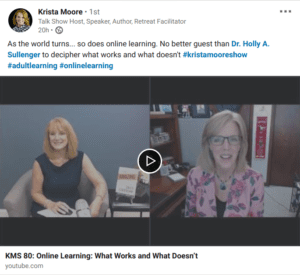
And here is another example: Guy Kawasaki is Canva’s evangelist and many of Mr. Kawasaki’s posts come back to talking about Canva.
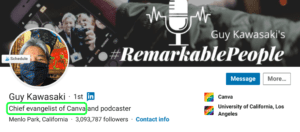
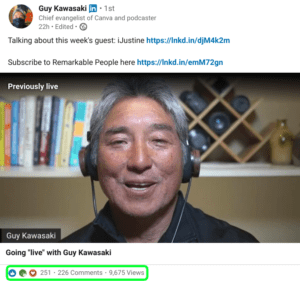
B2B Influencer Endorsements are <B2C
On the surface it seems like B2B influencers on LinkedIn come up short compared to B2C influencers on their preferred platform, Instagram. Here is an example, where Mr. Robert Blake endorsed Adobe Spark—a graphic design SaaS services:
This—you must agree—is an awesome format, where LinkedIn flags the post as “This article post is sponsored by…..”. It does look great, and similar to a typical influencer endorsement from the B2C world on Instagram, etc. However, the volume of LinkedIn influencer marketing endorsements is still meager compared to their brothers and sisters in the B2C segment.
For example, comparing the number of posts marked #Sponsored between the two platforms, there are almost 130 sponsored posts in Instagram for each sponsored post on LinkedIn.
25,000 on LinkedIn:
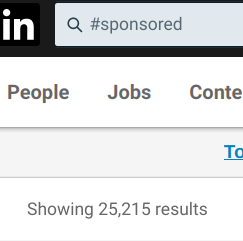
vs… 3M on Instagram:

While it is possible that the difference can be accounted for by the fact that B2B influencers are just less likely to mark their posts #sponsored, that difference is also an indication that the LinkedIn B2B influencers market is less mature compared to Instagram.
Beware of “Most Recognized” B2B Influencers
As with any new trend, there are a lot of assumptions and guesswork. According to a white paper on B2B Influencer Marketing published by the Dear Mishu’s Dad team in March 2020, an analysis of the ten individuals most commonly recognized in the press as B2B influencers reached some interesting conclusions.
The white paper analyzed the last 50 posts of these influencers on both LinkedIn and Twitter (for a total of 1,000 posts). Its main conclusion, which provides an important lesson for all brand managers, is that the accounts featured on the typical end-of-the-year “Top B2B Influencer” lists that pop up at the top of web searches are not very influential.
In fact, the engagement rate for these recognized B2B influencers is shockingly low:
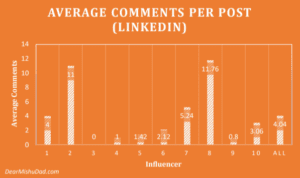
Interestingly, the study demonstrated that there is a wide divergence of performance among the highly recognized B2B influencer accounts that were analyzed. The average number of comments is just 4.06 comments per post, and, when the outliers are removed, the average is under 2 comments per post.
When comparing their performance on typical engagement KPIs to B2C influencers, which often get hundreds, even thousands of comments and Likes per post, this low level of engagement shows an almost complete inability for most of these influencers to spark conversation on LinkedIn.
Now, some may argue that comparing B2B and B2C influencers is like comparing apples to oranges, but if the goal is to generate as much engagement from B2B influencer marketing as one does from B2C, it makes sense to use the same standards.
Great Marketers are Not Necessarily Influencers
The same research points out that 8 of the 10 most widely recognized B2B influencers [page 14] are marketers. That means that they have a marketing background, make their careers as marketers with marketing goals, go to marketing conferences, write marketing whitepapers and marketing books, etc.
When you think about that, it isn’t surprising that marketers are great at marketing themselves and are good at getting recognition on LinkedIn.
“How To Make $170,000 With Online Challenges Or Events.”…
Mr. Kagan is a world-class marketer …
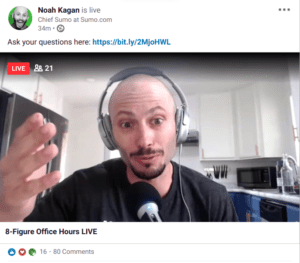
According to our B2B Influencer Marketing white research, that makes sense, because:
- Marketers know how to build awareness for brands. In this case, the brand is themselves, and they can push themselves to gain recognition because … they are good at marketing
- The type of content that does well on LinkedIn tends to be marketing-related. A review of trending LinkedIn posts show that they mostly focus on sharing information about a brand or product or telling a brand story, with very little technical discussion.
The takeaway here is that companies can certainly consider working with B2B influencers on LinkedIn who are marketers, but that they should be realistic in their expectation for engagement.
At the same time, if brands are looking for more technical influencers, for example if you are looking for an influencer who will show and convince technologists to move to a new standard or AppsStore Platform, perhaps Twitter and Twitch are better places to look to find those B2B influencers.
Trey Hunner is an example of a non-marketer B2B influencer working and influencing at Twitter.
Twitch has become an interesting place for B2B influence when tech influencers record their work process:

and:
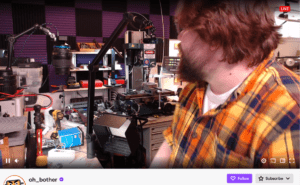
Perhaps the right way is to find the sweet spot when looking to work with influencers on LinkedIn: look for accounts that are not technical, but also not pure marketers. Find those who can generate conversation and are actively engaged in your industry. One old trick (translation: copied from Twitter’s playbook) to find these influencers is simply to ask your LinkedIn followers who they follow, listen to, or recommend you to work with for your B2B brand—for example:
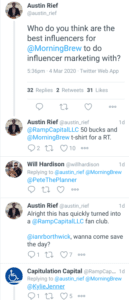
What can we conclude?
B2B influence is becoming more prevalent on LinkedIn. Companies should be prepared—that includes their LinkedIn company pages—to move toward generating discussion, dialog, emotions, community building and good storytelling on LinkedIn.
Brands can benefit from working with influencers on LinkedIn if they keep the following in mind:
- Engagement matters: No matter how high-profile someone is on LinkedIn, if their posts don’t consistently generate conversation related to your industry and re-shares, they are not influential.
- If your audience is marketers, working with the high-profile influencers who are also marketers may be a good choice—that is, if the people you are trying to reach follow them.
- Brands would be smart to choose people to work with whose posts are related to what the brands do. Look for those “subject matter experts” and, if you can’t find them on LinkedIn, look on Twitter or Twitch where they may be more active.
Alternatively—and that’s a rule with B2C influencers too—a brand can choose to work with someone who does not necessarily have great LinkedIn engagement but who can create proven, amazing content that you can repurpose on your website, catalog, whitepapers, conferences, seminars and what not.
In short—B2B marketers can benefit from engaging with influencers on LinkedIn—if they choose the right partners for the right reasons. Good luck, corporate heroes!
“N.G.” Gordon writes, speaks, and advises on influence and engagement on social media and influencer marketing as Dear Mishu Dad. He is also the creator of DearMishu, an Advice Columnist that has become a social media influencer, based on his dog. Connect with him on LinkedIn.
Favorite